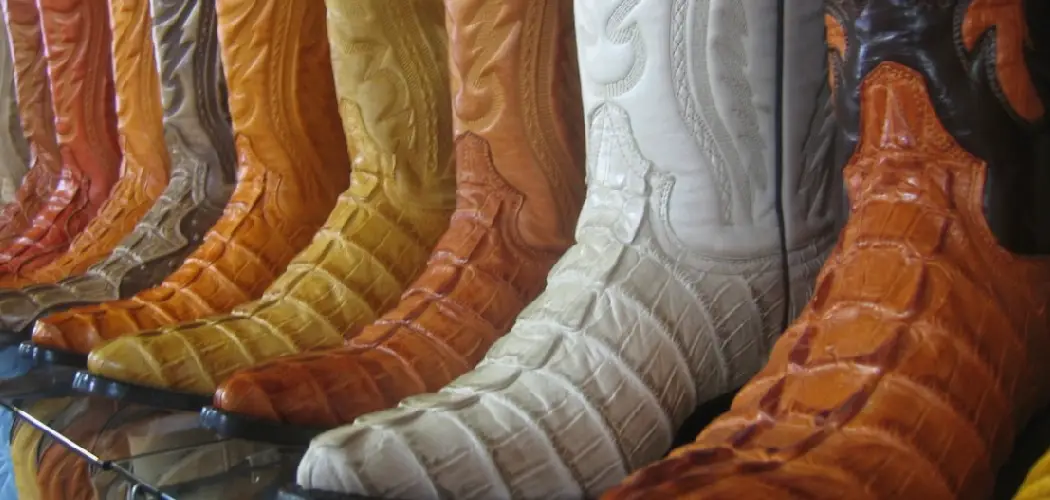Winter shoes, such as boots and waterproof footwear, are invaluable during the colder months, protecting us from the elements. However, as the season changes, the question arises of how to store winter shoes effectively to ensure they remain in the best condition for the years to come. Proper storage is crucial for preserving the functionality and appearance of winter footwear, extending their lifespan, and maintaining their quality.
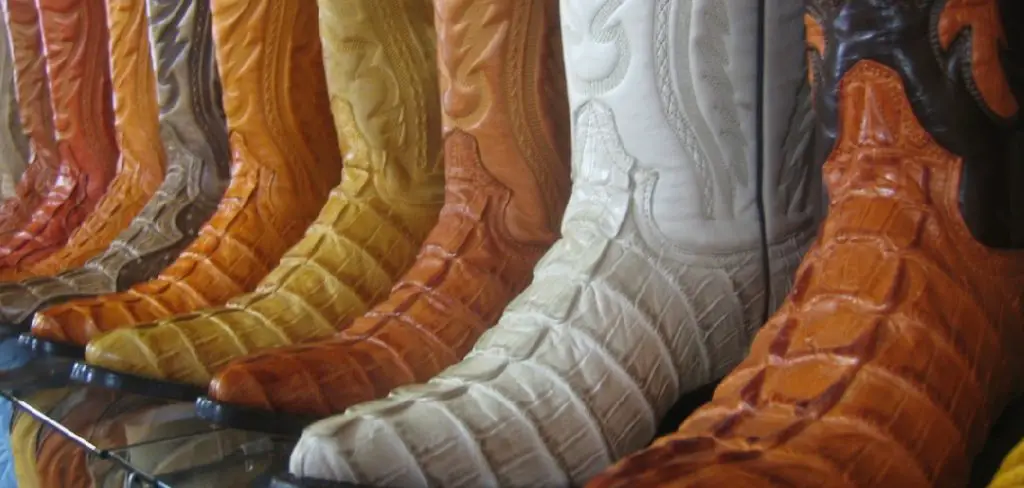
This guide will explore various strategies to safely and efficiently store winter shoes during the off-season months. We aim to provide a comprehensive overview of effective winter shoe storage techniques through detailed insights and practical tips, ensuring your cherished footwear remains in top condition until the next season beckons. Understanding how to store winter shoes correctly saves time and money and ensures your footwear is ready to face the winter weather once again.
Clean and Prepare Shoes
The initial step in preparing your winter shoes for storage is a thorough cleaning. Over the winter months, shoes accumulate various contaminants including dirt, salt, and moisture. Start by removing any surface dirt with a soft-bristled brush. For stubborn salt stains and embedded debris, use a damp cloth. Special attention should be given to the nooks and crannies of the shoes where dirt tends to accumulate.
After cleaning, it’s essential to allow your shoes to dry completely. This step cannot be rushed, as storing shoes with residual moisture can lead to mold and mildew growth, which can ruin the material and cause unpleasant odors. Depending on the material, drying can take anywhere from a few hours to a full day. Place the shoes in a well-ventilated area away from direct heat sources to ensure even drying.
Conditioning your winter shoes is an optional but highly recommended step, especially for those made of leather or suede. A leather conditioner helps restore moisture lost during the drying process, keeping the material supple and preventing cracks. For suede shoes, a specialized suede protector can offer additional protection against water and stains. Similarly, waterproofing sprays create a protective barrier on the shoe surface, extending their lifespan and preparing them for the next winter season. This preparatory process ensures your footwear remains in optimal condition, safeguarding your investment and ensuring they are ready to use when winter returns.
How to Store Winter Shoes: Choose Suitable Storage Containers
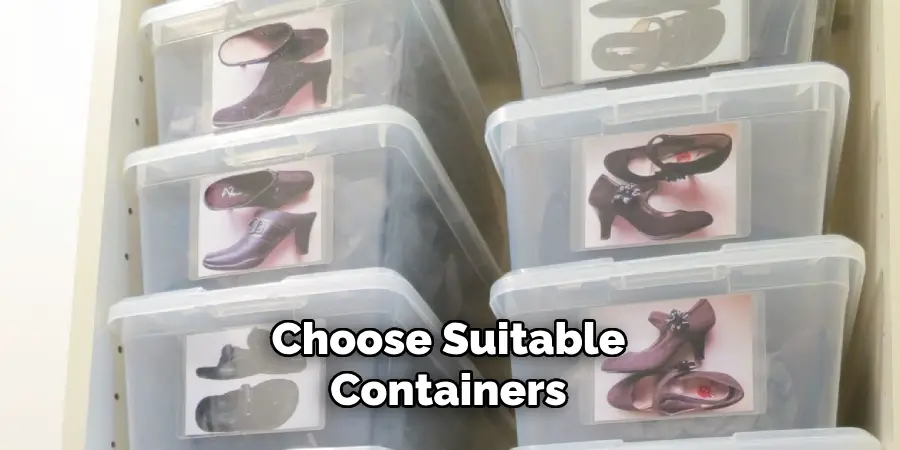
Choosing the right storage containers is a critical step in properly storing winter shoes. Here’s a closer look at the options available and how they can be utilized to keep your footwear in pristine condition.
A. Shoe Boxes
Clear plastic shoe boxes are an ideal choice for storing shoes. Their transparency lets you easily identify the contents without opening each box, saving time and hassle. These boxes protect your shoes from dust and moisture, which can cause damage over time. Additionally, the stackable design of plastic shoe boxes makes efficient use of space, allowing you to organize your footwear neatly. However, it’s important to ensure that the shoes are completely dry before placing them in the boxes to prevent mold growth.
B. Storage Bins
Ventilated storage bins with lids are an excellent option for larger winter footwear like boots. These bins offer ample space, accommodating boots that might not fit into standard shoe boxes. Ventilation is crucial for preventing the buildup of musty odors, ensuring that your shoes remain fresh during storage. Choose bins made of durable materials to protect your shoes from potential damage and elements. When selecting bins, consider modular ones for convenient stacking and storage.
C. Hanging Shoe Organizers
Hanging shoe organizers with pockets are perfect for maximizing vertical storage space in closets. This option is particularly useful for those with limited floor space. Shoe organizers can be hung on closet rods or doors, providing easy access to your footwear. The individual pockets help to segregate shoes, preserving their shape and preventing scuffs. Opt for organizers made from breathable materials, such as canvas or mesh, to promote air circulation and keep your shoes in optimal condition.
Implementing these storage solutions will help maintain the condition of your winter shoes and streamline your wardrobe organization. By carefully selecting the right storage containers, you can ensure your footwear is protected, easily accessible, and ready for the next winter season.
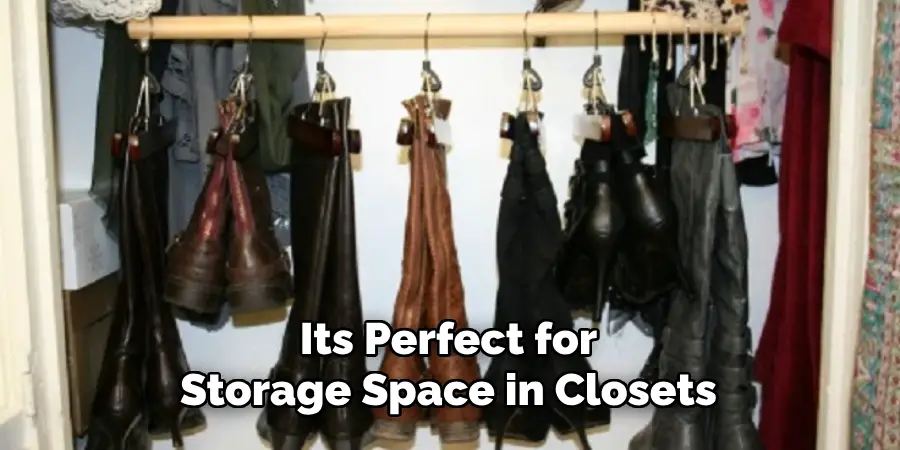
How to Store Winter Shoes: Arrange Shoes Properly
Once your winter shoes are clean, dry, conditioned, and selected in the right container, the next crucial step is to organize them properly. Proper arrangement keeps your footwear in optimal condition and makes accessing them easier when the next winter season arrives. Here are some guidelines to ensure your shoes are arranged effectively:
A. Stack Carefully
When using shoe boxes or bins for storage, it’s important to stack them carefully. Place the heavier items at the bottom and the lighter ones on top to avoid excessive weight on the lower boxes, which can lead to crushing or deformation of the shoes inside. This is especially true for delicate materials like leather or suede that can easily crease or lose their shape. The stackable design of many storage containers is ideal for maximizing space while minimizing damage, but always consider the weight distribution to preserve the integrity of your footwear.
B. Alternate Placement
Place shoes in alternate directions within each box or bin to maximize space and ensure proper ventilation. This means positioning one shoe with the toe facing forward and the other with the toe facing backward. This arrangement takes advantage of the shoes’ natural shape and empty spaces, allowing for more compact storage. Additionally, it promotes air circulation around the shoes, which is critical for preventing moisture buildup and the associated risks of mold and mildew, especially in sealed containers.
C. Maintain Order
Organizing your shoes by type or frequency of use is crucial for maintaining order and ensuring easy access when the season changes. Labeling each box or bin with a brief description of its contents (e.g., “Heavy Snow Boots” or “Leather Ankle Boots”) helps you find what you’re looking for without the need to open and sift through multiple containers. For even greater efficiency, you may arrange the shoes to place those used most frequently at the most accessible locations, such as on lower shelves or at the front of your storage area. Conversely, special occasion winter footwear that’s seldom worn can be stored higher up or in less accessible spots.
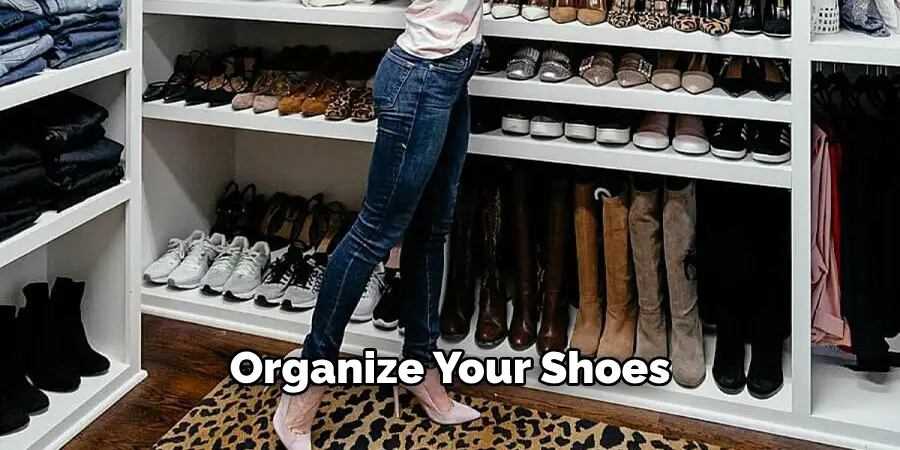
Adhering to these arrangement strategies ensures that when the chill of winter begins to approach again, you’ll be able to quickly and effortlessly access your well-preserved, organized footwear ready for the seasons to come.
Store in a Cool, Dry Location
Storing winter shoes in a suitable environment is crucial for preserving their condition and extending their lifespan. After cleaning, conditioning, and selecting the right storage containers, the final step is to choose an appropriate location that ensures your footwear remains in the best possible state until the winter season returns. Below are key considerations to bear in mind:
A. Choose a Suitable Location
The ideal place for storing winter shoes is a cool, dry area away from direct sunlight and heat sources. Extreme temperatures and sunlight can cause materials like leather and suede to dry out, crack, or fade. Similarly, high heat can distort the shoe’s shape and degrade adhesive materials that hold parts of the shoe together. Therefore, closets inside living spaces, under-bed storage areas, or climate-controlled rooms are optimal choices. Ensuring the storage area is well-ventilated will further protect your shoes from potential damage caused by environmental conditions.
B. Avoid Damp Areas
It’s imperative to avoid storing winter footwear in basements, attics, or other areas prone to moisture and humidity. Damp conditions foster the growth of mold and mildew, which can not only ruin the appearance of shoes but also produce unpleasant odors and potentially degrade the material’s quality. If options are limited and such areas must be used, it’s crucial to take extra precautions, such as using moisture-absorbing products or ensuring adequate ventilation to protect your shoes.
C. Use Dehumidifiers (Optional)
In areas where humidity levels tend to be high, using a dehumidifier can be an effective way to maintain optimal conditions for shoe storage. Dehumidifiers help regulate the air’s moisture level, preventing the damp environment that encourages the growth of mold and mildew. While not essential for everyone, this step can offer additional peace of mind, particularly for those storing valuable or particularly susceptible types of footwear. Remember that the goal is to create a stable environment that closely mimics ideal storage conditions, ensuring your winter shoes remain pristine and ready for when the cold weather circles back.

Protect Against Pests
An often overlooked aspect of storing winter shoes for the long term is protecting them against potential pest invasions. Certain pests, including moths, silverfish, and various insects, can cause significant damage to your footwear, especially those made from natural materials such as leather or wool. Implementing precautionary measures to deter these pests will ensure your shoes remain impeccable throughout their storage period. Here are some effective strategies:
A. Use Natural Repellents
Placing natural repellents like cedar chips, lavender sachets, or cloves within your shoe boxes or bins can significantly reduce the risk of moth and insect infestation. These natural options offer a dual benefit — they repel pests and impart a pleasant aroma to your footwear. Cedar, in particular, is renowned for its effectiveness against moths and also helps absorb moisture, which further prevents the conditions pests thrive in. Lavender sachets and cloves are equally beneficial, keeping pests at bay with their strong scents that are, however, non-damaging and pleasant to humans.
B. Check Regularly
Periodic inspections of your stored winter shoes can catch early signs of pest infestation, such as the presence of larvae or damage to the material. Doing so allows you to take prompt action to mitigate any issues before they become severe. Such check-ups also allow airing out the shoes, further discouraging pest habitation and maintaining the quality of the footwear.
C. Seal Cracks and Entry Points
Ensuring that storage containers are tightly sealed prevents pests from accessing your shoes. Check for any cracks or openings and use appropriate sealing methods to repair them. For storage bins with lids, ensure they fit securely. For added protection, consider using containers made of materials less susceptible to pest penetration, such as thick plastic or metal boxes. Sealing entry points keeps pests out and helps maintain an optimal storage environment that safeguards your shoes against various degradation factors.
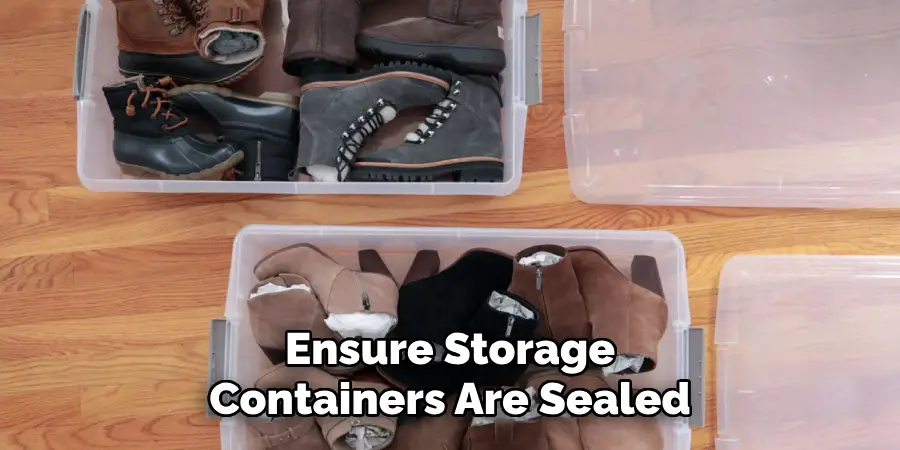
By incorporating these pest protection strategies into your winter shoe storage plan, you’re not just preserving your footwear; you’re actively taking steps to ensure that they remain in prime condition, free from damage caused by unwanted guests. This approach guarantees that when winter rolls around again, your shoes are as ready and resilient as when you stored them.
Rotate Shoes Periodically
An integral yet often overlooked part of preserving winter footwear is periodically rotating shoes. This step is not only about changing up which pair you might wear from week to week but also about safeguarding the longevity and appearance of each shoe during storage. Here’s why rotation matters and how it can protect your investment in quality footwear.
A. Prevent Creasing
It is vital to rotate shoes periodically to prevent creasing and maintain their shape. Shoes, especially those made from leather or suede, can develop creases and lose their original contour when left unused and weight-bearing for extended periods. You reduce the risk of creating permanent marks or deformations by alternating which shoes you place under direct pressure or at the top of a storage pile. This method ensures that each pair retains its intended shape and aesthetic appeal, extending the time they look new and fit well.
B. Air Out Shoes
Taking shoes out of storage occasionally to air them out prevents mustiness and the accumulation of undesirable odors. Shoes that are sealed away for months without exposure to fresh air can develop a stale smell, influenced by the moisture and bacteria that naturally accumulate in footwear. Periodic airing allows any built-up humidity to dissipate and refreshes the shoes, making them more pleasant to wear when the season changes. It also gives you the opportunity to refresh any desiccants or odor-controlling inserts you might be using.
C. Inspect for Damage
Check shoes for any signs of damage or deterioration during rotation and address as needed. Regular inspections can reveal early signs of wear or environmental damage, such as dry rot, mold, or pest intrusion, that might otherwise go unnoticed. Catching these issues early allows for immediate action, whether that means cleaning, repairing, or replacing protective storage materials. This proactive approach prevents minor problems from becoming major damages, ensuring that each pair of winter shoes remains in excellent condition for future use.
Incorporating these principles of rotation into your shoe storage routine enhances the aesthetic and functional longevity of your footwear and makes the transition between seasons smoother and more enjoyable.
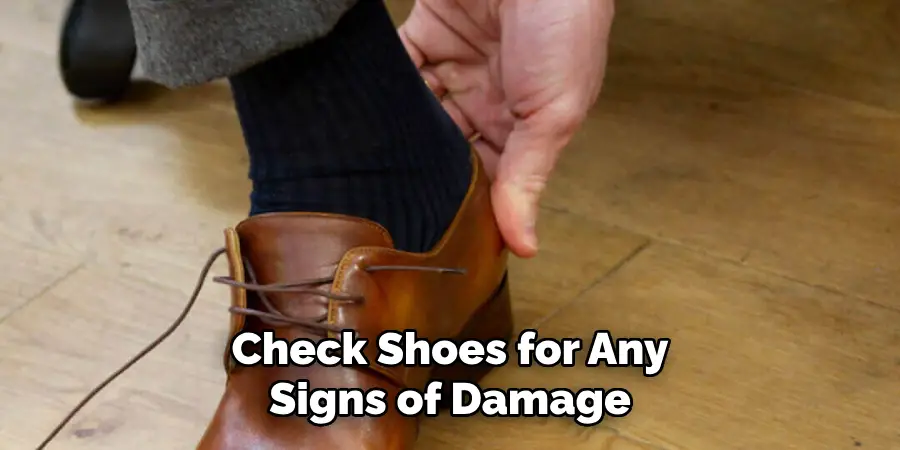
Frequently Asked Questions (FAQ’s)
Q1: Can I Store My Winter Shoes in Any Type of Storage Bin?
A1: For optimal protection, storage bins made of thick plastic or metal are recommended. These materials are less susceptible to pest penetration and moisture, better preserving your winter footwear against environmental factors and pests.
Q2: Is It Necessary to Use Natural Repellents Even if My Shoes Are Stored in A Closed Container?
A2: Yes, utilizing natural repellents like cedar chips, lavender sachets, or cloves in your storage containers can further deter pests and imbue your footwear with a pleasant scent. These measures are beneficial even in closed containers as they keep the shoes fresh and pest-free.
Q3: How Often Should I Rotate My Stored Winter Shoes?
A3: The frequency of rotation can vary based on storage conditions and personal preferences, but a general recommendation is to rotate your shoes at least once every 3-4 months. This practice helps prevent creases, moisture build-up, and odor accumulation, ensuring the footwear maintains its shape and quality.
Q4: What Should I Do if I Find Signs of Pest Damage or Moisture in My Footwear During Inspection?
A4: If you discover pest damage or moisture issues, remove the affected shoes from storage for cleaning and drying. Employ pest control measures if needed, and consider increasing the use of natural repellents and desiccants in your storage area. If the damage is severe, professional repair or replacement might be necessary. Always ensure your storage area is clean and dry before returning the shoes.
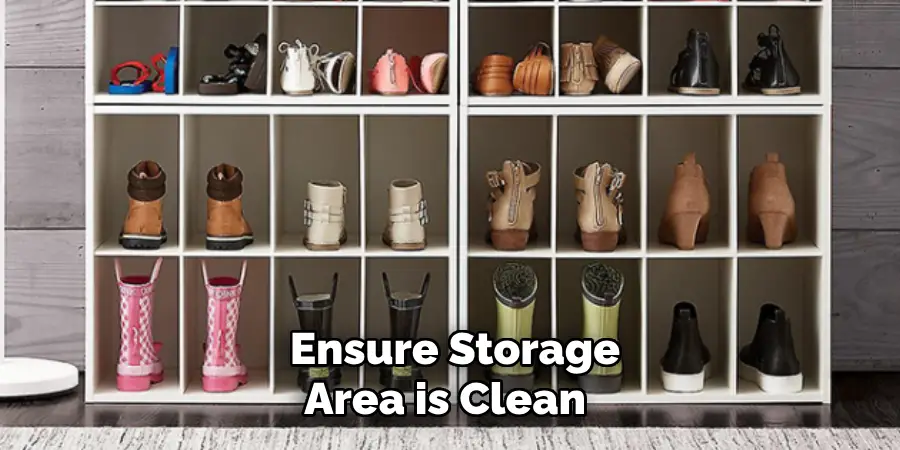
Conclusion
In summary, this guide has outlined essential techniques on how to store winter shoes to ensure they remain in top condition during the off-season months. We’ve discussed the significance of proper cleaning, selecting the right storage containers, choosing an optimal location, and the importance of regular maintenance practices such as pest control, air circulation, and periodic rotation. These steps underscore the critical nature of footwear preservation, particularly for items as seasonally specific as winter shoes.
By emphasizing the need for meticulous cleaning before storage, using appropriate containers, safeguarding against pests, and maintaining an environment conducive to longevity, we aim to equip you with all you need to protect your investment. We encourage you to apply these effective winter shoe storage strategies, ensuring your footwear stays well-preserved and ready for the rigors of the next winter season. Remember, a little effort in the off-season can save you time and money, as well as the inconvenience of premature replacements, keeping your winter boots in prime condition year after year.

